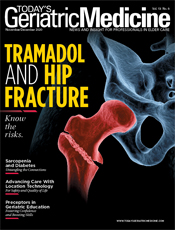
November/December 2020
From the Editor: Improving Quality of Life and Safety Diabetes and its complications can be devastating, even deadly, for older adults. So can sarcopenia. When the two occur together, the risks are multiplied and magnified. It’s increasingly recognized that diabetes may contribute to the development of sarcopenia, and there’s evidence that the reverse is also true; it appears likely that muscle loss affects glucose levels and over time may result in the development of diabetes. Because each of these prevalent conditions may erode quality of life and each can be life-threatening, it’s crucial that all clinicians who treat geriatric patients be aware of the intersection of these diseases in order to prevent devastating consequences. In her feature article, “Sarcopenia & Diabetes: Untangling the Connections,” contributor Jamie Santa Cruz discusses the ways in which diabetes can contribute to muscle loss; investigates the bidirectional association, exploring how muscle loss may lead to insulin resistance; and offers key takeaways for clinicians. Contributor Mark D. Coggins, PharmD, BCGP, FASCP, turns his attention to another common occurrence among older adults—hip fractures. In his feature article, “Tramadol and Hip Fracture,” he challenges the longstanding notion that the drug tramadol is a safer option for patients who’ve experienced hip fractures as well as the suggestion that it’s less likely than other opioids to result in dependence. On a related topic, Maura Keller reports on recent research indicating that patients scheduled for surgery for hip fractures or other conditions may benefit significantly from a presurgery course of wellness training—or prehabilitation. And in this issue, we continue to explore ways that technology and facilities are striving to reduce older adults’ exposure to the potentially deadly coronavirus. Deric Blattenberger looks at the role location technology plays in infection control and patient safety, and Eric Hansel, a UV lighting expert, looks at the role UV light plays in protecting older adults from COVID-19. Rounding out the issue, Barry Waldman, MD, highlights the importance of alleviating the emotional consequences of caregiving in the sandwich generation, and, on a lighter note, contributor Lindsey Getz explores the importance and art of preceptorship—a longstanding tradition in education that may have more value now than in times past. We want to hear from you. Tell us what issues concern you most and consider sharing your deepest concerns in an opinion essay for our “Last Word” column. Kate Jackson |
